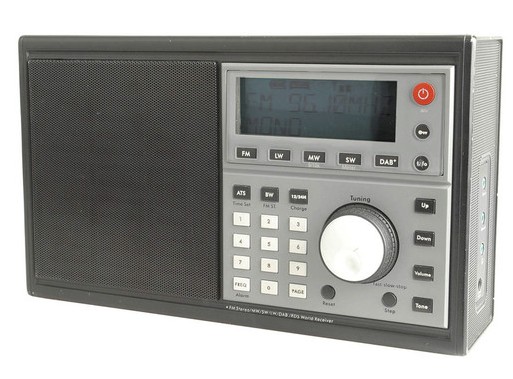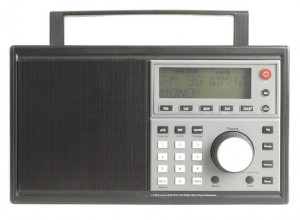 Many thanks to SWLing Post reader, Phil Ireland, who shares his review of the Digitech AR1946:
Many thanks to SWLing Post reader, Phil Ireland, who shares his review of the Digitech AR1946:
I’ve now purchased the AR1946 and I have to say, I’m very impressed! No noise problems at all with mine, although if you listen very carefully under certain conditions, you can discern a slight digital hash. Not in anyway imposing though.
This radio is super sensitive, AM comes very close to the CCRadio-EP in performance and FM is outstanding. SW is very impressive but there are a few quirks in tuning:
- below 10MHz, you hit the Frequency button, key in the value and hit the Frequency button again to tune [to the desired station]
- above 10MHz, you hit the Frequency button, type in the value and it jumps straight to the frequency [without pressing the Frequency button again].
Not a great issue but worth knowing.
This radio has 7 bandwidths in AM both accessible on MW and SW and rudimentary fine tuning with a separate wheel control. Unfortunately FM only has 1 bandwidth but seems well chosen. DAB+ is not available in Regional NSW so that cannot be commented on.
The telescopic antenna is ridiculously small but seems to pull in the signals with no problems. There are external antenna connections for improved performance.
Audio is very pleasant and you can control both treble and bass with the push of a button. The display is bright, well lit and easy to read with a useful tuning indicator.
There are a number of useful features and with 700 memories, there are more that needed. The radio is very reminiscent of the Grundig Satellit 700 in some respects. Build quality seems very good, time will tell if reliability becomes an issue.
What I don’t like is the radio partially mutes when tuning, this is annoying when bandscanning with the rotary tuning control. I have noticed what appears to be synchronous detection being used as occasionally when tuning onto a frequency, you will hear the detector lock on frequency. If so, there is no control over this feature. That may explain the display showing synch but the final model has automatic synch lock..
The AR1946 dispenses with Airband that was good on the AR1945 and SSB. Its a pity that SSB is omitted but along with the Tecsun PL310ET with DSP, they don’t have SSB capabilities as well. I suspect the same DSP chip is being used in this radio.
Can I recommend the radio? A resounding yes! As mentioned I’m very impressed. Try before you buy, though, as it may be that QC is variable along with many Chinese radios of late.
 Many thanks for your review, Phil!
Many thanks for your review, Phil!
When Phil notes a lack of noise in his receiver–he’s referring to a previous review we posted from Avo, who complained of internally-generated noise in his AR1946.
It seems, like with many other DSP portables (including the Sangean ATS-405) internally-generated noise may vary from unit to unit. I’m guessing this could have to do with slight variations in the board assembly (variations in soldering, grounding, shielding connections).
As Phil advises, please check your radio immediately after purchase and compare it to another shortwave portable if you have one available. This way, if you detect a noisy receiver, you can get a refund or exchange within the time limits of the return policy.

Hi all,
I had the opportunity to assess the capabilities of DAB+ on the 1946 while visiting my son in Sydney near Narellan. Location would be about 50 kms south west from the transmitters and I was surprised at just how good the DAB+ capabilities were on the radio. Audio was excellent and I was able to receive most DAB outlets with only the occasional dropout. Moving the radio closer to a window solved that issue and DAB reception was then rock solid. It was easy to toggle between the scrolling text and ID and the information shown on the display was adequate for general purposes. A big plus here!
I also checked out the FM-RDS capabilities and was happy with the radios performance here. The Sydney outlets were at full signal strength and the RDS performed faultlessly. Another big tick.
One thing I did omit from my previous assessment is that there is no option to adjust the RF Gain or attenuate the incoming signal on any band so there may be a chance to overload on external antennas. Having some form of control would be handy.
I’ve been using this radio a lot and must say I’ve been pleasantly surprised by it’s performance. from my perspective, it’s been a good buy.
Cheers and good DX….. Phil
Phil, Thanks for your post on the Digitech AR-1945 radio. I bought one two weeks ago and find the “Manual” very basic, and confusing! Do you know how to store a station’s frequency into a memory position, and sometime later on, retrieve it to listen again? I just can’t fathom it out! Any help will be very welcome.
Hi Lorri,
To tell you the truth, I haven’t ventured into the memory layout of the radio, I rarely use any memory features of any radio, preferring to either direct enter a frequency or use the tuning knob so I cant really help you there. I noticed the manual is very sparse so hopefully it can be worked out. Good luck with it.
Is it the 1945 or 1946 you have? If it’s the 1945, how do you find the SSB?
Cheers…. Phil
I forgot to add, no doubt readers would’ve noticed that I was optimistic in the number of memories! It’s actually 480 with a further 20 in DAB. Also I meant that having the Airband in the AR-1945 was a nice touch and it would’ve been good to have it in the 1946 as well. Typo there!
I will try the leading zero when tuning SW. You have to add a trailing zero when tuning FM as well but in MW, it is direct.
Cheers….. Phil
Hi Avo,
Thanks for the comments, I wonder if there is a way to adjust the AGC so as to speed it up a bit, it is definitely too slow. Having that chip would explain the lack of SSB as well.
Again, I enjoyed listening to the radio and was amazed at it’s performance with such a short aerial. I think attaching a short external antenna will boost it considerably further. I did connect it to an external FM antenna and was easily able to get RDS from the outlets in Orange about 60 kms away. Next time I’m in Sydney, I will bring the radio and test the DAB capabilities of it.
I did a brief comparison between the AR-1946, the Sangean ATS-803A and the Grundig Satellit 2400SL Professional with the Grundig faring better on SW due to it’s enormous antenna. In the most instances, the 1946 outperformed the Sangean except on a couple of frequencies on the 49 m Band.
I will add the summary of the radio I made on Avo’s page for interest here.
PROS:
Super sensitivity on all bands (DAB+ not tested)
Excellent selectivity specially on AM with no less that 7 bandwidths available
Very pleasant audio
Good build quality and well laid out panel. Good physical size of radio.
Bright, easy to read LCD display (see CON)
Soft mute that is a bane of many DSP sets is almost non evident
Multiple tuning features (See CON)
External antenna connections
Handy carry handle
CONS
Partially mutes on tuning with the rotary encoder. Makes band scanning for weak signals unnecessarily difficult.
Rotary encoder too sensitive, increments in 1 khz jumps on AM, would be better to have radio tune in smaller increments, say 100 khz. Again makes tuning with the encoder difficult.
Fine tuning control not really fine tuning! Tunes in 1 khz jumps on AM, way too coarse. Obviously added with the thoughts of SSB but no SSB offered.
No SSB as mentioned before.
Some useful display icons not available. It would be good to have had the SW metre bands displayed when in the SW mode. As would have been a clock displayed when the radio is on.
No Air band which is really a nice touch.
No IF out for DRM listening.
Some very slight digital and display noise but not imposing at all.
So there you have it, as I said, no radio is perfect but the AR-1946 is never the less very good. It’s a keeper for me with the only real issue for me the partial muting when tuning. That IS a pain!
I hope any purchasers of the radio also get good examples to avoid disappointment. With a good 1946, listeners should enjoy a great radio.
Cheers and good DX….. Phil
By the way Thomas, the images above are of the pre-production unit. The parent company to Jaycar (Techbrands / Electus) has the production images – which IMHO looks much classier than preproduction…..
http://www.techbrands.com/images/ocw/150006_600_500.jpg
http://www.techbrands.com/images/ocw/150007_600_500.jpg
http://www.techbrands.com/images/ocw/150008_600_500.jpg
http://www.techbrands.com/images/ocw/150010_600_500.jpg
Hmmm. I think I will go to another Jaycar store and get another unit based on your assessment Phil….
I think this unit has one of the new integrated Silicon Labs DAB chips (??Si468x) which includes all listed bands. This won’t be the same as in the 310ET as that unit does not have DAB or RDS capability. I do think however that it is the same as the Eton Field/Satellit models as Soulra (Eton Europe) has their models advertised with DAB capability.
As per Richard’s reply, the leading zero does the trick for < 10MHz frequencies on SW.
As for the partial muting when tuning on AM bands, this is the AGC operating. There is no Sync detector in the DSP chip, simply a slow and prominent AGC. Once it has ramped up, there is no notable soft muting on AM bands. There is slight soft muting on FM however, but only maybe 3db.
I’ve got this AR1733,
http://www.jaycar.com.au/Sight-%26-Sound-Personal/Music-Centres/Radios/PLL-World-Band-Radio/p/AR1733
But when I opened it, and rearranged the antenna wire, a lot of noise was gone …
Phil. Thanks for the review. Did you try a leading 0 (zero) when entering frequencies below 10MHz?
I’ll wait until an SSB model comes out, but the rest sounds good, What is the IF frequency and can an external BFO be added? AR1946 worth putting on the compare list.
The unit is SiLabs based. The SiLabs chips are fully digital receiver ICs wchich are connected to a HF input circuit and deliver the demodulated audio. The chips are parametred by a microcrontroller via I²C bus. There are no IF stages, neither filters.
DAB demodulation could be provided by another chip.